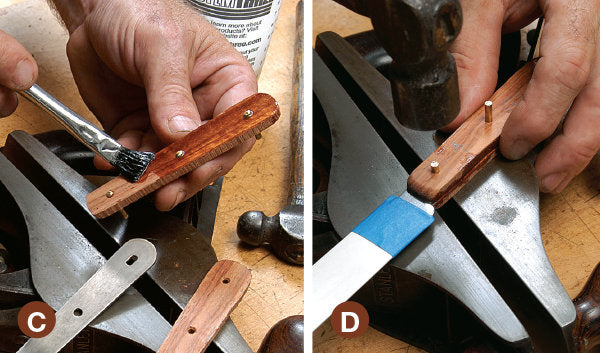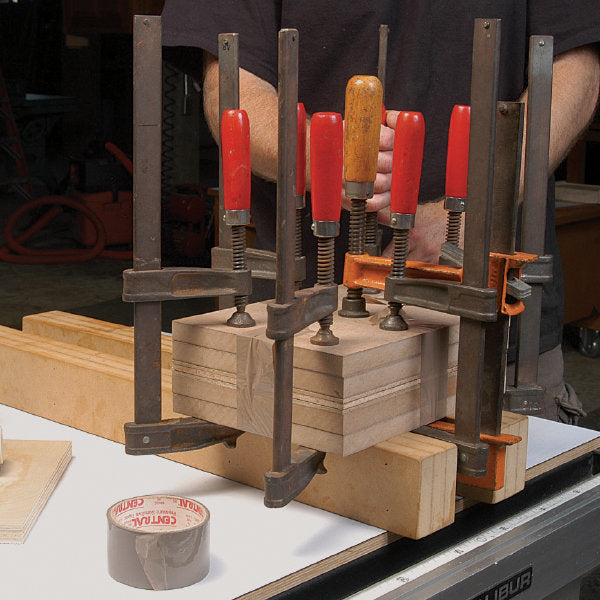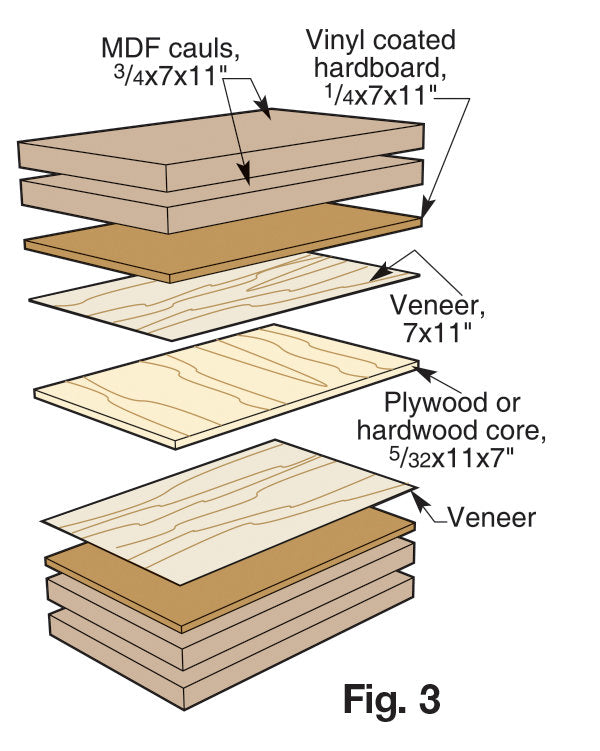
Showcase special woods with this impressive matched set.
Designer/Builder/Writer: Andy Rae
Here’s a two-part project that’s fun to make, and looks great below the yuletide tree. Both the steak knife handles and presentation box are made from a gorgeous Peruvian hardwood called orange agate (platymiscium sp.), which is a dense, tropical species from Peru (see page 70). It cuts well with sharp tools, takes a beautiful polish, and holds up to moisture—a good choice for kitchenware. The box holds six knives, but can readily be scaled up or down to hold more or fewer knives. A clever sliding lid snaps shut as if by magic thanks to two rare-earth magnets. The veneered lid, made from a figured piece of anigre, adds a nice contrast to the orange agate while letting you try your hand at simple veneering. Make the six knife handles first, so you can fit the box to the dimensions of the completed knives.

Start with the knife handles
1 MILL A BLANK FOR THE SIX HANDLES, keeping it oversized in thickness and length, or about 5/8×1×32". To match the grain pattern for each handle, mark the edge of the stock for matching assemblies later, and then resaw the blank in half on a bandsaw or a table saw. The two resulting strips should be enough to make 12 handle halves (A) (Figure 1). Thickness-plane the halves to 3/16" thick, making sure the inside faces are smooth and flat.
2 MARK THE KNIFE OUTLINES ON THE OUTSIDE FACE OF ONE HANDLE HALF, using a knife blank as a tracing template. Be sure to mark the hole locations on the stock, and label the individual blanks on this strip as well as its mate as shown in Photo A.
3 DRILL THE PIN HOLES IN THE HANDLE HALVES (A) on the drill press, using a 1/8" brad-point bit. Use a scrap backer board underneath the stock to prevent blowing out the underside.
4 BANDSAW THE HANDLE HALVES (A) TO ROUGH SIZE, being careful to stay outside your marked lines. (You can substitute a scrollsaw if you like.) To prevent splitting when you drive the pins, chamfer around each hole on the inside face of each blank using a handheld countersink or a countersink bit chucked into the drill press.
5 FINISH-SAND THE FORWARD (BLADE) ENDS OF THE HANDLE BLANKS, sanding a gentle curve and rounding the end by hand with some 120-grit sandpaper wrapped around a block of wood. Sand through the grits up to 220, paying attention to any scratches or irregularities, as it will be hard to touch up this area after assembly.


Glue the blanks to the blades
1 CUT 18 PINS INTO 1" LENGTHS from a 1/8"-diameter brass rod. To further prevent splitting the handle stock and to make installing the pins easier, bevel one end of each pin on a disc sander or with a fine file. Because the six pins for the forward holes in the knife blanks will be too tight to fit, you’ll need to pre-size them. To do this, drive each pin partway through the hole by laying the blank over a makeshift anvil and striking the pin with a hammer as shown in Photo B. Now withdraw it.
2 GLUE THE HANDLE HALVES TO THE KNIFE BLANKS WITH TWO-PART EPOXY. Tape the cardboard sheath that comes with the knife blank to the blank, to protect your fingers from the blade. Before spreading the adhesive, tap all three pins through one handle half, beveled end down, until the beveled tips register in the holes in the knife blank. Then, spread epoxy on each handle half, position both halves over the knife blank, and tap the pins through all three parts, starting with the forward pin as shown in Photos C and D.
3 CLAMP THE ASSEMBLY as shown in Photo E, WIPING AWAY EXCESS EPOXY on the knife blank with a clean rag dampened with denatured alcohol. Set the assembly aside to let the epoxy cure.
4 FILE OR SAND THE PINS FLUSH WITH THE HANDLE. Brass is relatively soft; a few swipes with a mill file, or a light touch on a stationary belt sander, should level the pins flush with the wood surface.
5 SAND THE HANDLE FLUSH WITH THE KNIFE BLANK, stopping when the edge of the knife blank is exposed. I used a stationary belt sander, but a mill file, followed up with some hand-sanding with 120-grit paper wrapped around a block of wood works just as well.
6 ROUND OVER THE EDGES OF THE HANDLE on the router table using a 1/8" round-over bit. To keep fingers safe, use a pushblock to move the workpiece, as shown in Photo F. (See also “Routing Small Parts” on page 48.)

Tap the pins partway through one handle half, spread epoxy on both halves, position the parts together, and then drive the three pins through all three parts, beginning with the forward pin.

Clamp the handle halves to the knife blank using moderate clamping pressure. Wipe away excess epoxy from the knife blank by dampening a rag with denatured alcohol.
Finish the handles
1 FINISH-SAND THE HANDLES UP TO 220 GRIT, then use some 320-grit wet-or-dry paper to smooth the face of the pins and the edges of the steel knife.
2 APPLY A HEAVY-DUTY FINISH so the handles will wear well in the kitchen. First, I applied a coat of dewaxed shellac to seal out any contaminates, smoothing the surface with a fine nylon abrasive pad once the finish had dried. Then I applied a few coats of a wipe-on polyurethane for maximum protection, using a small artist’s brush to coat the forward ends to avoid getting any on the blade, and a rag for the rest. I let the handles dry as shown in Photo G.

Keep fingers out of harm’s way when rounding the edges. Cover the blade with a cardboard sheath and use a grippy pushblock to move the work.

For a smooth finish, clamp a scrap piece of corrugated cardboard in a bench vise, then stick the knives into the cardboard while the finish dries.
Now for the presentation box
1 MILL THE SIDES (B), ENDS (C and D) AND THE PULL (E), referring to the Cut List. To keep the grain matched, mill the narrow end and the pull as one block of
oversized wood, approximately 7/8 ×25/8×7¼" then rip the block into separate parts and to final size on the table saw. Make sure to mark their orientation so you can put them back together in the correct order later.
2 CUT BOX JOINTS IN THE SIDES (B) AND ENDS (C and D), making ¼" fingers and ¼" slots. (See “Box-Joint Basics” on page 10.) Because orange agate is a brittle wood that is prone to chipping, I used a marking gauge to score lines around the stock before cutting the joints, which greatly reduces tear-out. To account for the difference in thickness between the sides and the ends, cut 3/8"-long fingers and slots in the end pieces, and 7/8"-long joints in the sides as shown in Photos H and I.
3 CUT THE LID (F) AND BOTTOM (G) TO SIZE, referring to the Cut List. You can use regular hardwood plywood in a species of your choice, but to make the box really stand out, opt for a select veneer with 3/16" thick solid stock (see “Veneering the Lid” on page 56).

4 ROUT THE GROOVES IN THE SIDES (B) AND ENDS (C and D) for the lid (F) and the bottom (G), using a ¼" straight bit chucked in the table-mounted router. Align the grooves with the fingers and slots as shown in Figure 2. The grooves are only 1/8" deep, which keeps the thin box sides strong. Cut through-grooves in the sides; then cut stopped grooves in the wider end (C) for both lid and bottom, and only one stopped groove in the narrow end (D) for the bottom only. Clamp stopblocks fore and aft of the bit on the table, and carefully lower the work onto the spinning bit as in Photo J. When the stock reaches the aft stopblock, carefully pivot the work up and away from the bit.
Note: You can cut the stopped groove for the bottom a tad longer than necessary, and then leave it as is since you won’t see it after glue-up. The stopped groove for the lid, however, should stop precisely 1/8" past the joint’s shoulder line. Once you’ve routed the grooves, square up the rounded ends on the lid groove with a small chisel. Check that the bottom sits securely in its grooves, and that the lid slides easily. Judicious sanding on the lid’s underside will free it up for ideal sliding action.
5 CUT THE SHOULDERS ON THE SIDES (B) FOR THE LID PULL (E), removing one finger at one end of each side where shown in Figure 2. I used a handsaw to make this cut and cleaned it up with a chisel, but you could make the same cut using the miter gauge on the table saw.
6 ROUND OVER THE SIDES (B) AND THE WIDER END (C), using a 1/8" round-over bit in the router table. For now, round over just the top inside and outside edges of the sides, stopping where they meet the wider end, and round over the top inside edge of the wider end (C). After assembly, round over the remaining edges, and finish up the stopped round-overs with chisels and careful sanding.
7 GLUE UP THE SIDES (B), ENDS (C and D) AND BOTTOM (G), gluing the box joints as well as the plywood bottom. Clamp the ends first, then the sides, and check for square. When you’re satisfied, place clamps directly over the box joints, using medium pressure to ensure the joints make good contact as shown in Photo K. Set the box aside on a flat surface to dry.
8 LAY OUT AND CUT THE CURVES ON THE ENDS (C and D) AND PULL (E), using two copies of the pattern shown in Figure 4. First, adhere the pull (E) on top of the narrow end (D) with double-faced tape, and spray-adhere a copy of the pattern on the stack. Glue the second pattern to the top edge of the wide end (C). Now bandsaw the curves to shape. Clean up the saw marks on a stationary belt or disc sander, being careful not to over-cut or over-sand. You’ll want to leave 3/8"-long fingers on the sides for a consistent, symmetrical look. Now rout 1/8" round-overs on the top edges and ends of parts (C) and (E) as well as the outside bottom edges of the box.
9 INSTALL THE DECORATIVE PINS. Cut six 1/8" brass pins about ½" long. Use the pattern in Figure 4 to lay out and mark exact pinhole locations in the box end and the pull. Drill the holes as before using a 1/8" brad-point bit on the drill press, making them about 3/8" deep. Apply epoxy to the pins then tap them into the holes. When the epoxy has cured, level the pins to the wood with a mill file or sanding block.

Use a 1/4" dado blade to cut 7/8" fingers in the sides and 3/8" fingers in the ends.

Pivot the workpiece down and onto the bit and move it forward until it contacts the opposite stopblock.

Clamp the ends and the sides with bar clamps, checking that the assembly is square. Finish by clamping over the joints.

Veneering the Lid
To make the presentation box really pop, veneer the lid from a wood of your choice. I chose highly figured anigre, an African wood that often displays tightly-packed curls across the grain, but practically any species will look great. Cut all your materials oversize, or about 7×11", as shown in Figure 3.
You’ll need four pieces of ¾"-thick MDF (medium-density fiberboard) to act as cauls, two pieces of ¼"-thick vinyl-coated hardboard to resist glue squeeze-out (you can substitute regular plywood instead if you give it a good coat of wax), plus a core of 5/32"-thick hardwood plywood with its face grain running opposite to the veneer.
Be sure to veneer both sides of the lid with the same or similar wood to stabilize the panel. Use a foam roller to place an even coat of regular white or yellow glue onto both faces of the core (never on the veneers), and then quickly position the veneers, core, hardboard, and cauls, and tape the package on each edge to avoid slippage.
Place the assembly over tall blocks. Then clamp from the center out. Once the glue has dried, level and smooth the surface by sanding with 120 grit up through 220, and then cut the lid to the finished dimensions in the Cut List.

Assemble the lid and pull
1 CUT A STOPPED RABBET IN THE PULL (E) on the router table, again using a straight bit to make the cut. Raise the bit height ¼" and set the fence for a 1/8" cut. As before, set up stopblocks on both sides of the fence to limit the cut, stopping the cut ¼" from each end. Square up the rounded ends with a chisel.
2 GLUE THE PULL (E) TO THE LID (F), using a single bar clamp to draw the pull into the edge of the lid, and a couple of clamps to bring pressure down on top of the pull and onto the lid’s face. Once the glue dries, check the fit of the lid in the box, and make any necessary adjustments. The lid should slide easily and close with the curved pull flush with the curved end of the box.
3 TO CREATE THE CLOSING SYSTEM FOR THE LID, lay out and mark the centered hole in the edge of the narrow box end (D) for the rare-earth magnet. Then lay out and mark the underside of the lid’s pull, this time centering the hole along its length, but offsetting it 1/16" towards the outside of the pull. This offset creates a pulling action when the lid is closed. Next, chuck a 3/8" Forstner bit in the drill press, and drill holes about 1/8" deep so the magnets sit slightly below the surface of the lid and box. Orient the magnets so they attract each other and epoxy them into their respective holes and let cure.

Divide the box interior
1 CUT THE SLOTTED BOTTOM (H) TO SIZE AND MILL THE END BLOCKS AND DIVIDERS (I, J, K, L) to the dimensions in the Cut List. Check the fit of the slotted bottom in the box, perhaps starting out oversized and then shaving its edges with a small plane for a precise fit.
2 NOW CUT THE SLOTS IN THE SLOTTED BOTTOM (H) ON THE TABLE SAW, raising the blade to full height and adjusting the fence for each cut. Refer to Figure 5 for the slot layout, and use a standard plywood-cutting blade to make the 1/8"-wide slots. Clamp a stopblock to the far end of the saw fence as shown in Photo L on page 58 to stop the cut. Make sure to stop the saw each time to safely remove the panel for the next cut.
3 ROUND THE LEADING EDGES OF THE DIVIDERS (J, K, L), laying out the ¾"-radii on one block and sawing it to shape on the bandsaw (see Figure 4). Clean up the saw marks and fair the curve on a stationary belt sander or by hand, and then use that divider to lay out and shape the remaining blocks.
4 ROUND OVER THE END BLOCKS (I) AND THE DIVIDERS (J, K, L), again using a 1/8" round-over bit in the router table. As before, use a pushblock to guide the small pieces past the spinning bit. Finish-sand all the blocks and dividers, as well as the slotted bottom, up to 220-grit.
5 INSTALL THE SLOTTED BOTTOM (H), placing a few beads of glue underneath and weighting the plywood down for a flat, solid bond.

6 GLUE AND CLAMP THE END BLOCKS (I) ON TOP OF THE SLOTTED PLYWOOD. Use only a moderate amount of glue to avoid squeeze-out.
7 ATTACH THE DIVIDERS (J, K, L) TO THE BOTTOM WITH GLUE, using spacers to position them. I made spacers from scrapwood, using 1/2" -wide spacers for the handle dividers and 1/8"-wide spacers for the blade dividers. Arrange the blocks with the spacers to make sure they fit before spreading any glue, then apply glue to the end dividers first, and press them into position against the sides and down onto the plywood. Finish up by installing the remaining dividers, again coating them with glue and pressing them into place as shown in Photo M.

Layout marks on the plywood help set the fence for each cut. Raise the blade and push the part into the saw, stopping when the panel contacts the stopblock. Turn off the saw before removing the panel.

Arrange the dividers using scrap spacers, and then install them by pressing them in place with glue.
Finish the box
1 SAND THE BOX UP TO 220 GRIT and apply the finish of your choice. To keep the look in tune with the knives, I chose the same finish regimen that I used on the handles, although I didn’t apply as many coats: one coat of shellac to seal the wood, followed by two coats of wipe-on poly.
2 RUB IT OUT FOR A BEAUTIFUL SHINE. When the finish has cured thoroughly (it takes about a week), rub out the entire box and the knife handles with paste wax to smooth the finish and protect the surface. Now, sign the box, fill it with the knives, and present it to someone special.


